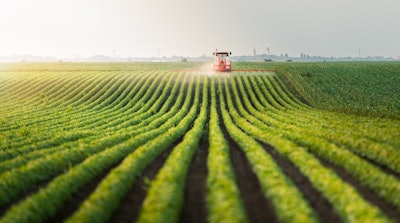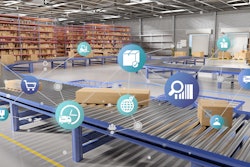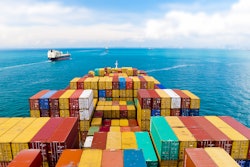
When 2021 hit, the world was ready for the New Year. Even if it brought with it a New Normal -- new way of doing business, a new way to shop for groceries and more -- the turning of the calendar meant putting a year of supply chain disruptions, restaurant closures and constant pivoting behind us.
But, then, on March 23, a stranded Evergreen container ship blocked navigation in Egypt’s Suez Canal, setting the stage for what would be a slew of supply chain disruptions after supply chain disruptions.
Suddenly, 2021 was quickly becoming a mirrored reflection of the year prior.
Then came the ransomware attacks, internet outages, container ships stuck at bay, bridge closures, driver shortages, ingredient shortages, natural disasters and more.
The hits just kept on hitting.
And, industry experts are already showing signs of struggle for 2022 into 2023, as routes to import/export remain clogged, ports continue to be backed up, cost of doing business increases and the labor shortage exists.
That’s because supply chains are messy. And, they’re only going to get worse before they get better.
In Food Logistics’ Nov/Dec 2021 issue, editor-in-chief Marina Mayer talks with several industry experts about the state of the supply chain and what’s in store for 2022.
Here’s an interview with Waylon Sharp, VP and COO of food and agriculture at Bureau Veritas North America, who details why companies can longer ignore the need to achieve a resilient supply chain, with excerpts publishing in Food Logistics’ Nov/Dec 2021 issue. [CLICK HERE to read the article in full].
Food Logistics: 2021 started off with supply chain disruption after supply chain disruption. From the Suez Canal blockage and natural disasters to ransomware attacks and an industry-wide labor shortage, the supply chain industry is having to prove its resiliency over and over again. Looking into 2022, what does the state of the supply chain look like?
Waylon Sharp: I believe disruptions in this volatile landscape will continue to impact the already overextended supply chain in 2022. Supply chains are facing exponential stress with the increasing population, in addition to various geopolitical, economic, health and climate change related factors.
The global food supply chain is intended for free flow of goods globally, but in our landscape dotted with trade wars, labor shortages, civil unrests, health crisis and more, I expect the supply chain to evolve in 2022, with added layers of resilience.
Companies can no longer ignore the need for a resilient supply chain. Over the course of the past year, many have seen the major impact supply chain disruption can have on operations, regardless of cause or location. I anticipate more businesses will utilize digital supply chain risk management solutions like Supply-R to obtain total visibility on the known—and unknown—risk threatening processes, which will help businesses plan ahead and develop a more resilient supply chain. Digital supply chain management solutions can help minimize shocks to demand, pricing and logistics, and drive supply chain value through a focus on risk management and process control. Ultimately, businesses are able to build better supplier ecosystems that are based on transparency and trust.
Food Logistics: The cold food chain continues to face a host of risk/security challenges. What can companies be doing now to adapt for the future?
Sharp: One large risk factor is the changing climate conditions and increasing frequency of extreme weather events that continue to put pressure on the cold food supply chain. I could envision a not-so-distant future where two shifts could happen:
1. Onshoring. Offshoring had long been a solution to gain access lower cost labor markets. The increasing costs for logistics and weather disruptions are swinging the economics in favor of domestic production
2. Inlanding. If my prediction around onshoring is correct, then the follow-on impact could see less dependency on import/export ports and a move to produce foods in areas less susceptible to climate-related supply chain disruptions
Food Logistics: In terms of transportation, what are some of the trends you’re seeing for 2022? How do emerging technologies like blockchain, Internet of Things, cloud-based, etc. play a role in the evolution of transportation in the cold food chain?
Sharp: The trend for more information will continue to gain momentum. Monitored, verified and inspected transportation will shift from a want to a need. With this information, consumer pressure for greater transparency may finally be achievable through this transfer of information.
Food Logistics: Let’s talk supply chain visibility. What is your company – or what should companies – be doing to improve their own supply chain visibility?
Sharp: Our organization has invested in, and continues to invest in, tools to convert manual inputs (such as supply chain audit and inspection reports) into digital information. It should be noted that many raw materials still originate from areas with little to no access to internet. Further, such investments extend how that information is then aggregated and customized to become actionable by customers to the betterment of food safety.
We launched Supply-R in July 2020 to address visibility challenges. Supply-R is a digital solution designed to meet companies’ new challenges relating to supplier network reliability and ensuring business continuity in all circumstances, through supply chain visibility based on factual data from the field, to make sure that all elements are properly addressed, assessed and observable.
Food Logistics: The labor shortage is a real thing, and it’s impacting several facets of the supply chain. What is your company – or what should companies – be doing to hire, onboard and retain good quality supply chain workers?
Sharp: Companies should be finding ways to compensate employees’ in line with the market and round out their experience by offering a combination of flexibility, career progression, recognition and rewards. There are also many sections of a supply chain that can benefit from technology to replace those that leave the industry, effectively deploying high-experienced, quality supply chain individuals in roles that maximize value for both the employee and the organization.
Food Logistics: The COVID-19 pandemic put extra emphasis on food safety and worker safety. What is the state of food safety and worker safety going into the New Year?
Sharp: If supply chains are made simpler and shorter because production moves closer to demand, food safety will benefit. If organizations recognize the value of employee retention and recruitment, then worker safety will improve as there will be more investments made in infrastructure, tools and resources to foster safe work environments.
Food Logistics: When it comes to grocery retail shopping and/or foodservice establishments, what are some trends you see sticking around post-pandemic, and which ways of doing business will somewhat go away?
Sharp: I could see the increased consumer demand for curbside pickup, takeout and delivery continue to prevail, as both retail and foodservice have created products better suited for home consumption and the delivery networks have made step gains. For this trend to endure, sustainable packaging and logistics will have to improve as consumers seek to make more responsible food and food experience choices.
[CLICK HERE to read the article in full].



















